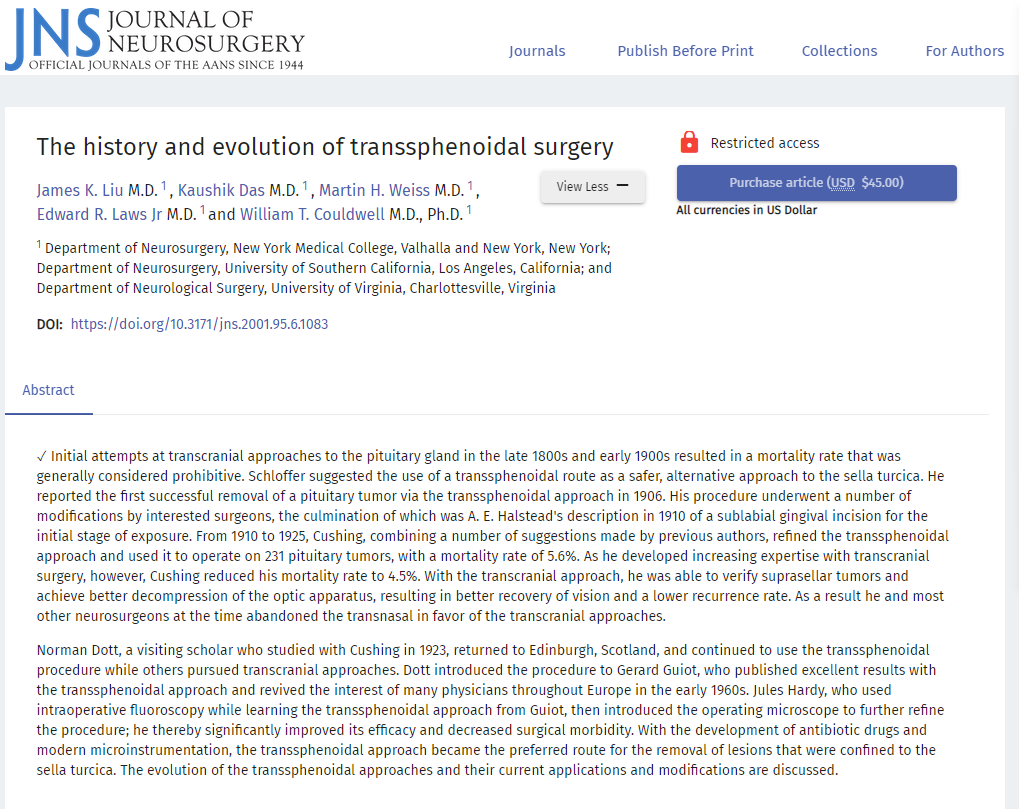经蝶窦手术的历史与演变(The history and evolution of transsphenoidal surgery)
英文简介:
Initial attempts at transcranial approaches to the pituitary gland in the late 1800s and early 1900s resulted in a mortality rate that was generally considered prohibitive. Schloffer suggested the use of a transsphenoidal route as a safer, alternative approach to the sella turcica. He reported the first successful removal of a pituitary tumor via the transsphenoidal approach in 1906. His procedure underwent a number of modifications by interested surgeons, the culmination of which was A. E. Halstead's description in 1910 of a sublabial gingival incision for the initial stage of exposure. From 1910 to 1925, Cushing, combining a number of suggestions made by previous authors, refined the transsphenoidal approach and used it to operate on 231 pituitary tumors, with a mortality rate of 5.6%. As he developed increasing expertise with transcranial surgery, however, Cushing reduced his mortality rate to 4.5%. With the transcranial approach, he was able to verify suprasellar tumors and achieve better decompression of the optic apparatus, resulting in better recovery of vision and a lower recurrence rate. As a result he and most other neurosurgeons at the time abandoned the transnasal in favor of the transcranial approaches.
Norman Dott, a visiting scholar who studied with Cushing in 1923, returned to Edinburgh, Scotland, and continued to use the transsphenoidal procedure while others pursued transcranial approaches. Dott introduced the procedure to Gerard Guiot, who published excellent results with the transsphenoidal approach and revived the interest of many physicians throughout Europe in the early 1960s. Jules Hardy, who used intraoperative fluoroscopy while learning the transsphenoidal approach from Guiot, then introduced the operating microscope to further refine the procedure; he thereby significantly improved its efficacy and decreased surgical morbidity. With the development of antibiotic drugs and modern microinstrumentation, the transsphenoidal approach became the preferred route for the removal of lesions that were confined to the sella turcica. The evolution of the transsphenoidal approaches and their current applications and modifications are discussed.
中文简介:
在19世纪末和20世纪初,较初尝试经颅入路切除脑下垂体的尝试导致了普遍被认为是不可行的死亡率。Schloffer建议采用蝶窦入路作为蝶鞍顺利的替代入路。1906年,他报道了首例通过蝶窦入路成功切除垂体瘤的病例。他的手术经过了许多感兴趣的外科医生的修改,其结果是1910年a·e·霍尔斯特德(a . E. Halstead)对切口暴露初期的描述。从1910年到1925年,库欣结合前人的一些建议,改进了经蝶入路,并将其用于231例垂体瘤的手术,死亡率为5.6%。然而,随着他在经颅外科方面的技能不断提高,库欣的死亡率降到了4.5%。经颅入路可以证实鞍上肿瘤,实现更好的视器减压,视力恢复更好,复发率更低。因此,他和当时的大多数神经外科医生都放弃了经鼻入路,转而采用经颅入路。
诺曼·多特(Norman Dott)是1923年在库欣学习的访问学者,他回到苏格兰爱丁堡,继续使用经蝶窦手术,而其他人则采用经颅入路。Dott把这个手术介绍给Gerard Guiot,他发表了经蝶入路的结果,并在20世纪60年代早期重新引起了欧洲许多医生的兴趣。Jules Hardy在向Guiot学习蝶窦入路时使用了术中透视法,然后引入了手术显微镜来进一步完善手术过程;因此,他显着提高其疗效和降低手术发病率。随着抗生素药物和现代显微仪器的发展,蝶窦入路成为切除局限于蝶鞍病变的优选路径。讨论了经蝶窦入路的发展及其目前的应用和改进。

该研究主要人员之一是INC国际神经外科医生集团旗下组织国际神经外科顾问团(WANG)成员William T. Couldwell教授。William T. Couldwell教授擅长领域涵盖脑膜瘤、脑胶质瘤、脑动脉瘤、颅底手术、中风、创伤性脑损伤、头部创伤和神经重症护理等方方面面。擅长脑膜瘤等脑部、颅底、神经肿瘤、垂体肿瘤、癫痫和脑血管神经外科等的外科治疗。主要研究包括颅底肿瘤的外科管理;脑胶质瘤、垂体腺瘤与脑膜瘤中的信号转导与凋亡;多种神经外科疾病如动脉瘤和各种脑瘤的遗传性等。
资料来源:https://thejns.org/view/journals/j-neurosurg/95/6/article-p1083.xml




